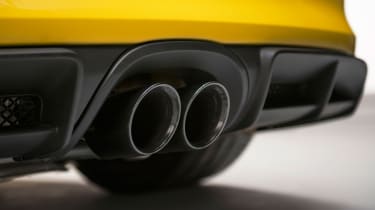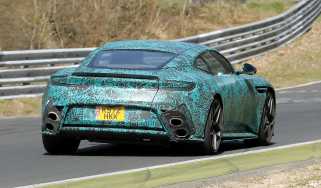Aftermarket exhaust upgrades – do they bring worthwhile power and noise improvements?
Aftermarket exhaust systems can unlock missing noise and power from your performance car – here’s how

Listening to a tuneful engine note is one of the joys of driving a performance car, but it’s becoming increasingly harder for manufacturers to engineer great sound into their models. Ever more stringent noise and emissions regulations have dulled sound levels and necessitated the fitment of particulate filters and, in some cases, power-sapping additional catalytic converters.
That’s where aftermarket exhausts come in. A properly designed upgraded system can unlock the latent potential of an engine while releasing more noise and also being lighter and more durable than OEM components in some cases. If you choose wisely, an aftermarket system doesn’t need to be excessively noisy or boomy either (although indecently loud unsilenced systems are available, if volume is what you’re after). Below is a rundown of how they’re designed, how they extract more from your engine and where the lines of legality lie.
What makes up an exhaust system?
The layout of an exhaust system varies depending on the type of car, number of cylinders, location of the engine and so on, but most are made up of similar common components. Starting from the top, the manifold (or ‘header’) collects exhaust gases directly from each cylinder of the engine, unifying the flow into a downpipe which then connects to a catalytic converter to reduce harmful emissions.
Then comes a particulate filter for diesel cars (and newer petrol models), which links to a centre section (often fitted with a silencer) followed by the backbox silencer and tailpipe. Most mainstream cars use steel for these components, but high-end performance cars and aftermarket options can use stainless steel for corrosion resistance, or lightweight metals such as titanium or Inconel – a nickel-based superalloy.
Tuning companies can offer upgraded components separately, but their systems are often designed to work as a complete package to optimise the gas flow all the way from engine to tailpipe.

Upgraded exhaust systems
On mainstream production cars, OEMs are constrained by development and material costs (plus noise/emissions legislation) when designing exhaust systems, leaving potential gains on the table that aftermarket systems are designed to extract. Generally, the goal is to give the exhaust gases a more efficient exit route through the system, which can be achieved by carefully calculated pipe routing, lengths and diameters, as well as smoother bends and welding work. Ceramic coatings are sometimes used too, which retain heat inside the pipework to speed up the gases and lower engine-bay temperatures, while resisting corrosion.
These days, the expertise of certain aftermarket companies has caught the attention of OEMs, resulting in crossover between the two. For example, UK firm Janspeed began developing aftermarket systems for Minis in the ’60s before becoming an established player for a wider range of brands, and now counts Bentley, Aston Martin and Lotus among its OEM partners. Then there’s Akrapovic, an aftermarket supplier that also makes OEM exhausts for the likes of Alfa Romeo and Volkswagen.
Upgraded manifolds and downpipes
A number of manifold configurations are available that offer different methods of flowing the exhaust gases from each cylinder into a single stream. For example, a 4-2-1 system collects gases from four cylinders and combines them into a pair of pipes, before these converge into a single pipe. A 4-1 set-up meanwhile – as the name suggests – combines the four primary runners straight into a single pipe. This tends to improve top-end power, where a 4-2-1 boosts the midrange. Unequal and equal length manifolds are also available, with the primary pipes in the former using a direct path from the engine to the downpipe and the latter a more complex route to make gases from each cylinder travel the same distance.
When it comes to the diameter of an exhaust bore, bigger isn’t always better. As a general rule, a smaller bore will provide faster exhaust flow and more low-end torque, with a larger bore reducing back pressure to improve power at higher revs. Turbocharged cars are a special case, as they benefit from high-speed gas flow upstream of the turbocharger to spin it up quickly, which is usually achieved by a smaller-diameter manifold. After the turbo, larger-diameter pipework is beneficial to reduce back pressure and maximise boost response. Aftermarket downpipes are a popular way of achieving this.

There is, of course, a balance to be struck, and the exhaust diameter should be matched to the power output of your engine – go too big and the gases won’t flow through the system quickly enough. Aftermarket manufacturers will usually suggest a suitable pipe diameter based on your engine specs.
Upgraded catalytic converters (sports cats)
In the name of reducing back pressure, aftermarket manufacturers offer upgraded catalytic converters that are less restrictive than OEM items while still being road legal in some cases.
Inside a catalytic converter is a honeycomb structure with numerous channels covered in specially devised metal coatings to promote chemical reactions with exhaust gases and reduce harmful emissions. Compared to a standard cat, a sports cat reduces the number of these channels (referred to as cells) to improve exhaust flow and release a better sound. Despite the lower number of cells, many sports cats still reduce emissions below the required level to pass an MOT, but it’s worth confirming this with the manufacturer before fitting one. When it comes to legality, removing the cat and installing a cat replacement (or decat) pipe is another matter, which we’ll cover later.
Upgraded back boxes and silencers
One of the most common exhaust upgrades is a sports back box – sometimes referred to as a ‘cat-back’ exhaust. Swapping out the standard back box for something less restrictive can bring a dramatic change in the tone and sound of your engine, while potentially unlocking extra performance. Key to this is the design of the silencer, which on a road car tends to offer a careful balance of performance and sound. Generally, an unimpeded, free-flowing system with minimal silencing gets more out of an engine, but can also fire out anti-social (and illegal) noise levels.

‘Performance-wise, a straight-through exhaust is best,’ explains Janspeed’s engineering manager James Heppell. ‘But we create systems that still optimise gas flow while keeping a reasonable noise level and a tuned, mature sound. The main thing is removing the awful boom you get with some systems at mid-revs.’
One way around the issue of excessive noise is using a valved exhaust system. Many modern performance cars come with switchable exhaust settings from the factory, and some aftermarket offerings can give this functionality to older models via a valve controller and remote inside the car. On cars that have a valved exhaust from the factory, aftermarket systems can sometimes be linked up to the standard interior switches/drive modes to retain OEM functionality.
Legality
There are certain dos and don’ts when it comes to aftermarket systems. Decating your car by replacing the catalytic converter with a straight-through pipe will render it illegal for road use if it was first used in or after September 2002, as an MOT test requires the cat to be in place. Cars must also comply with certain emissions targets depending on their age, and removing the cat from a car fitted with one from the factory will likely cause it to exceed these. However, as long as your car meets the required noise limits for a trackday, it can be used on a circuit without a cat.
There are noise restrictions for road use, too. Since 2016, the UK has followed the EU 540/2014 regulation for new cars, which states that a model must not exceed 72dB during type approval tests. According to UK law, it is illegal to modify the exhaust system to make it louder than it was at type approval, but for an MOT, the tester must use their own judgement to assess whether the exhaust system is unreasonably loud for that particular car compared to how it would sound if it were fitted with a standard silencer, which isn’t a scientific test.
In the UK, the Driver and Vehicle Standards Agency is clamping down on the use of decat pipes in road cars, as well as ‘pop and bang’ engine maps which retard the ignition and reduce fuel cut-off on the overrun to produce loud crackles that can exceed acceptable noise limits. A tuning company was prosecuted in 2023 for installing these modifications on cars likely to be used on the road, without warning customers.
Test: Lotus Elise S1 OEM exhaust v upgraded Janspeed system

evo’s Fast Fleet Lotus Elise S1 was treated to Janspeed’s upgraded stainless steel exhaust system, comprising a 4-2-1 manifold, link pipe, sports cat and rear silencer, for a back-to-back test with the OEM set-up. These were the results:
‘It’s almost a shame to hide the stainless steel pipework down in the engine bay, but the only hint of the new system once fitted is the gleaming double-barrel tips poking out of the bumper. The Elise isn’t a car that draws attention to itself and I wanted it to stay that way, and on start-up the exhaust now has a deeper, more purposeful but still cultured tone. At low speeds the engine definitely feels more present behind you, then as you wind it out to 7200rpm it sounds fierce, with a much fuller note that hardens into an addictive blare at the top end. Yet the exhaust doesn’t drown out the old-school burble and intake noise that make the K-series so characterful; rather it just amplifies its voice.
But the best bit is how much more free-revving it is. I’m very conscious that extra noise can easily give the illusion of more power, but there’s definitely more urgency in the way the Elise sweeps through the revs now. I’ve been considering a lightweight flywheel to give the engine more zip but the exhaust has had a similar effect (to a lesser extent). Even a gentle rev match feels noticeably crisper than before. The full system doesn’t come cheap, but being stainless steel it’ll hopefully last the lifetime of the car and, with the engine sounding and feeling angrier, it’s made every drive that bit more exciting.’
Yousuf Ashraf, evo 333




